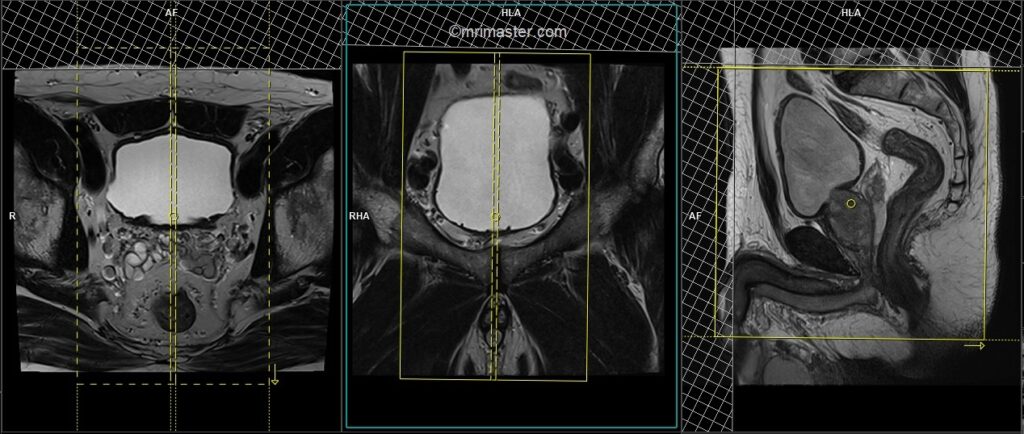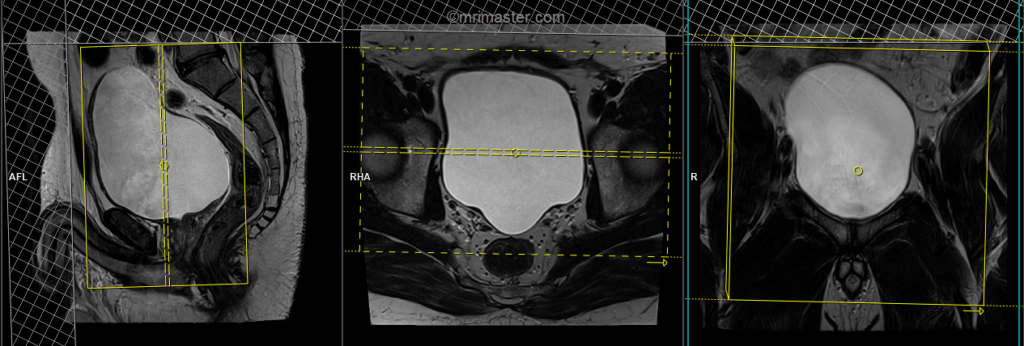MRI Urinary Bladder(Protocols and Planning)
Indications for MRI urinary bladder
- Check the invasion of bladder wall by transitional cell cancer or other pelvic neoplasm
- Characterise mass or atypical cyst at ultrasound and CT
- Allergy to iodinated contrast media
- Staging of urinary bladder carcinoma
- Malformation (children)
- Cystocele
- Fistula
Contraindications
- Any electrically, magnetically or mechanically activated implant (e.g. cardiac pacemaker, insulin pump biostimulator, neurostimulator, cochlear implant, and hearing aids)
- Intracranial aneurysm clips (unless made of titanium)
- Pregnancy (risk vs benefit ratio to be assessed)
- Ferromagnetic surgical clips or staples
- Metallic foreign body in the eye
- Metal shrapnel or bullet
Patient preparation for MRI Urinary Bladder
- A satisfactory written consent form must be taken from the patient before entering the scanner room
- Ask the patient to remove all metal objects including keys, coins, wallet, cards with magnetic strips, jewellery, hearing aid and hairpins
- If possible provide a chaperone for claustrophobic patients (e.g. relative or staff )
- Contrast injection risk and benefits must be explained to the patient before the scan
- Gadolinium should only be given to the patient if GFR is > 30
- Offer earplugs or headphones, possibly with music for extra comfort
- The patient should have a full bladder.
- Instruct the patient to keep still
- Note the hight and weight of the patient
Positioning for MRI Urinary Bladder
- Position the patient in supine position with head pointing towards the magnet (head first supine)
- Position the patient over the spine coil and place the body coil over the pelvis - lower intercostal border down to 5cm below symphysis pubis)
- Securely tighten the body coil using straps to prevent respiratory artefacts
- Give a pillow under the head and cushions under the legs for extra comfort
- Centre the laser beam localiser over anterior superior iliac spine (5cm below iliac crest)

Recommended MRI Urinary Bladder Protocols and Planning
MRI Urinary Bladder localiser
A three-plane T2-weighted HASTE localizer must be taken initially to localize and plan the sequences. These fast, single-shot localizers usually have an acquisition time of less than 25 seconds, which is excellent for localizing pelvic structures.

T2 tse sagittal 3mm SFOV
Plan the sagittal slices on the coronal plane, angling the positioning block parallel to the urinary bladder (i.e., parallel to the pubic symphysis and median sacral crest). Check the positioning block in the other two planes. An appropriate angle must be given in the axial plane (parallel to the line along the linea alba and the median sacral crest). Slices should be sufficient to cover the entire urinary bladder from the right acetabular rim to the left acetabular rim. Using a saturation band above and in front of the sagittal block will help reduce artifacts caused by breathing and peristalsis.

Parameters
TR 4000-5000 | TE 100-120 | SLICE 3 MM | FLIP 130-150 | PHASE A>P | MATRIX 320X320 | FOV 200-250 | GAP 10% | NEX(AVRAGE) 2 |
T2 tse axial 3mm SFOV
Plan the axial slices on the sagittal plane and angle the positioning block horizontally across the urinary bladder. Check the positioning block in the other two planes. An appropriate angle must be given in the coronal plane, horizontally across the urinary bladder. Slices should be sufficient to cover the urinary bladder from L1 down to two slices below the symphysis pubis. To reduce artifacts from breathing and peristalsis, consider using a saturation band above and in front of the axial block.

Parameters
TR 4000-6000 | TE 100-120 | SLICE 3 MM | FLIP 130-150 | PHASE R>L | MATRIX 320X320 | FOV 200-250 | GAP 10% | NEX(AVRAGE) 2 |
DWI epi 3 scan trace axial 3mm SFOV pelvis
Plan the axial slices on the sagittal plane and angle the positioning block horizontally across the urinary bladder. Check the positioning block in the other two planes. An appropriate angle must be given in the coronal plane, horizontally across the urinary bladder. Slices should be sufficient to cover the urinary bladder from L1 down to two slices below the symphysis pubis. To reduce artifacts from breathing and peristalsis, consider using a saturation band above and in front of the axial block.

Parameters
TR 6000-7000 | TE 90 | IPAT ON | NEX 3 5 8 | SLICE 3 MM | MATRIX 192X192 | FOV 200-250 | PHASE R>L | GAP 10% | B VALUE 0 |
T2 tse coronal 3mm SFOV
Plan the coronal slices on the sagittal plane; angle the positioning block vertically through the urinary bladder. Check the positioning block in the other two planes. An appropriate angle must be given in the axial plane (parallel to the right and left hip joints). Slices must be sufficient to cover the entire urinary bladder from the anterior abdominal wall up to the rectum. Using a saturation band above and in front of the coronal block will help reduce artifacts from breathing and peristalsis.

Parameters
TR 4000-5000 | TE 100-120 | SLICE 3 MM | FLIP 130-150 | PHASE R>L | MATRIX 320X256 | FOV 200-250 | GAP 10% | NEX(AVRAGE) 2 |
T2 stir coronal 5 mm big FOV
Plan the large field of view (FOV) coronal slices on the sagittal plane and position the block parallel to the lumbar spine. Verify the positioning block in the other two planes as well. Establish an appropriate angle in the axial plane, which runs parallel to the right and left hip joint. The slices should adequately cover the entire abdomen and pelvis, extending from the anterior abdominal wall to the sacrum. The FOV must be large enough to encompass the abdomen and pelvis, typically ranging from 380mm to 400mm. Large FOV scans are usually performed to evaluate the local spread of the pathology and assess the para-aortic and pre-sacral nodes.

Parameters
TR 4000-5000 | TE 110 | FLIP 130 | NEX 2 | SLICE 5MM | MATRIX 384X320 | FOV 380-400 | PHASE R>L | GAP 10% | TI 130 |
T1 VIBE DIXON 3D sagittal dynamic 1 pre 5 post
Plan the axial slices on the sagittal plane and angle the positioning block horizontally across the urinary bladder. Check the positioning block in the other two planes. An appropriate angle must be given in the coronal plane, horizontally across the urinary bladder. Slices should be sufficient to cover the urinary bladder from L1 down to two slices below the symphysis pubis. To reduce artifacts from breathing and peristalsis, consider using a saturation band above and in front of the axial block.

Parameters
TR 6-7 | TE 2.39 4.77 | FLIP 10 | NEX 1 | SLICE 3 MM | MATRIX 224X224 | FOV 220-260 | PHASE R>L | DYNAMIC 6 SCANS | IPAT ON |


